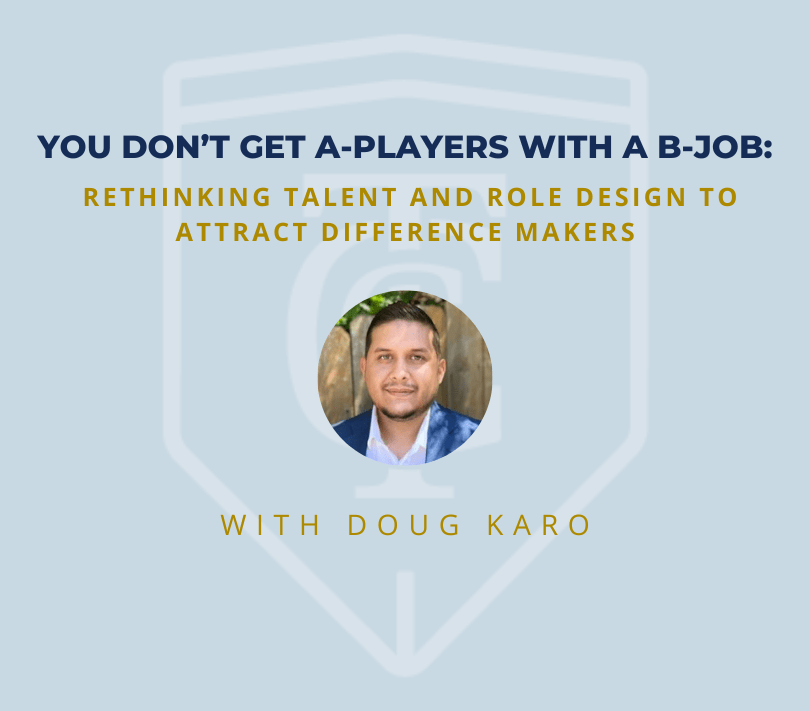Everyone wants to hire top talent. A-players. High-impact, high-ceiling people who elevate teams, challenge the status quo, and drive results. But here’s the uncomfortable truth: You don’t attract A-players with a B-level job. Too often, companies ask recruiters to find rockstars but offer vague job descriptions, average comp, and limited growth. If you’re not clear about why the role matters, where it’s going, or what kind of talent it actually deserves, you’re setting yourself up to hire safe over standout. Here’s what I’ve learned as a headhunter working with leaders across industries:
1. The Myth of “Just Find Me a Rockstar”
This is one of the most common requests I get: “We’re looking for a high-performer. Someone who can lead change. A real difference maker.”
Then I get the job spec, and it reads like a backfill from 2016.
You can’t expect someone operating at an A-level to be inspired by a role that screams B-minus. The best talent isn’t just looking for a job—they’re looking for a mission.
2. What Makes a Job an A-Job?
If you want to attract elite talent, your role needs to be worthy of elite talent. That means more than adding “strategic” to the title.
An A-job typically has:
-
Clear impact: How will this role move the needle?
-
Visibility: Will the person have access to leadership and decision-makers?
-
Stretch: Is there room for growth, challenge, and influence?
-
Support: Will they be set up to win, or buried in politics and red tape?
These are the questions top candidates ask—consciously or not—within the first 10 minutes.
3. What Do A-Players Want?
They’re not just chasing money or titles (though those matter too).
A-players want:
-
Purpose and autonomy: They want to own something that matters.
-
Smart teammates: A-players want to work with other A-players.
-
Challenge: They’re not afraid of the grind; they’re afraid of being bored.
-
A clear runway: What’s the next step if they succeed?
If your role doesn’t offer those things—or if you’re not articulating them—you’re going to lose top talent to competitors who do.
5. How to Bridge the Gap (If You Actually Want Marquee Talent)
If you’re serious about attracting marquee talent—the kind of people who transform teams, drive strategy, and elevate everyone around them—then your hiring approach needs to match that ambition. Here’s the hard truth: You don’t land top-tier people with bottom-tier planning. Too many organizations bring recruiters in after the role is set, the budget is locked, and the opportunity has already been watered down. Then they wonder why the shortlist looks “underwhelming.” If you want to compete for game-changers, here’s what needs to happen:
-
Partner early: Bring your recruiter in at the strategy stage, not the post-and-pray stage. We can help you shape a role that will resonate with top talent—before it’s boxed in by legacy thinking or internal politics.
-
Be willing to stretch: On comp. On title. On how the role is scoped. A-players don’t move for sideways steps or cookie-cutter positions—they move for challenge, visibility, and upside.
-
Ask the hard question: Would you leave your job for this one? If the answer is no, why would someone elite say yes?
This isn’t about selling harder. It’s about building better—better roles, better strategy, better alignment between what you want and what you’re offering. Top-tier talent responds to intention. If you’re not intentional, you’re not in the game.
6. Build Roles People Want to Run Toward
You can’t expect top talent to chase mediocre roles—or vague ones. If you want to land A-players, the job itself needs to pull them in. That means crafting roles that are challenging, rewarding, and purposeful—then telling the story in a way that resonates with the kind of people you want to attract. Lead with:
Top talent doesn’t just want a job—they want to feel something when they hear about it. They want to see the opportunity, the runway, the impact. So don’t just post a description. Build a role worth running toward—and tell a story worth listening to. That’s where real hiring success begins.
About Doug Karo, Recruiting Manager
 With over a decade of experience in executive search, Doug is a seasoned professional renowned for delivering top-tier talent acquisition solutions. Specializing in Human Resources, he excels at identifying and securing high-caliber talent across diverse industries and functions. Doug has successfully partnered with prestigious organizations, including Vail Resorts, Trader Joe’s, Freedom Financial, Eisner Health, and Boart Longyear, among others. To learn more about Doug, visit his bio page.
With over a decade of experience in executive search, Doug is a seasoned professional renowned for delivering top-tier talent acquisition solutions. Specializing in Human Resources, he excels at identifying and securing high-caliber talent across diverse industries and functions. Doug has successfully partnered with prestigious organizations, including Vail Resorts, Trader Joe’s, Freedom Financial, Eisner Health, and Boart Longyear, among others. To learn more about Doug, visit his bio page.

 With over a decade of experience in executive search, Doug is a seasoned professional renowned for delivering top-tier talent acquisition solutions. Specializing in Human Resources, he excels at identifying and securing high-caliber talent across diverse industries and functions. Doug has successfully partnered with prestigious organizations, including Vail Resorts, Trader Joe’s, Freedom Financial, Eisner Health, and Boart Longyear, among others. To learn more about Doug, visit his bio page.
With over a decade of experience in executive search, Doug is a seasoned professional renowned for delivering top-tier talent acquisition solutions. Specializing in Human Resources, he excels at identifying and securing high-caliber talent across diverse industries and functions. Doug has successfully partnered with prestigious organizations, including Vail Resorts, Trader Joe’s, Freedom Financial, Eisner Health, and Boart Longyear, among others. To learn more about Doug, visit his bio page.
